Did Rome”fall”
Did Edward Gibbon in 1776 agonise over the choice of a title of his Magnum Opus? Or did his publisher influence the choice of title? Whoever made the choice “Decline and fall” certainly has a better ring to it than “Metamorphosis” It conjures up images of decadence which has a certain fascination and has been seized upon by several generations of film-makers. However the evidence is that the Roman Empire did not “fall” in the commonly accepted sense.
The Takeover
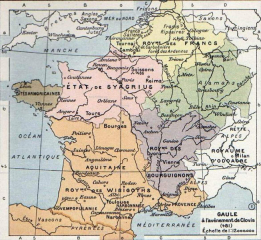 At the time the Pope appointed Clovis as the chosen one, remnants of the Roman Empire still existed in Northern Gaul and Western Britain. The roman leader in Gaul we know was named Syagrius but thanks to the principle that it is the victors write history, we have no idea what role he played. Some British records say that his contemporary in England was named Arthur but we know even less about him.
The Francs, Alamans and Burgundians had assumed control in different parts of the Empire and redistributed much of the land to their own tribe. Obviously those who had lost their land would bear resentment. Strong control and the imposition and enforcement of laws to protect the rule of the new regime were necessary.
In the Gothic territories the Roman system still applied. The Gothic families took the place of the patricians, the aristocratic Roman Families, but made themselves rich in the same way the Roman Families had done, from the proceeds of holding public office.
Clovis defeated both Alamans, Sygarius and the Visigoths in just four battles. He failed to defeat the Burgundians and formed a temporary alliance with them to defeat the Visigoths. Only the battle against the Alamans seems to have been bitterly contested. Particularly in the case of the Visigoths the Visigothic army changed sides or “melted away”. What Clovis was careful to do was murder the leader of the opposite side.
In the case of the Alamans therefore the Comptes simply had to switch their allegiance to Clovis. However for both the remnant of Syagrius’ domain (to become Normandy and Anjou)and the Visigothic lands(to become Aquitaine), Clovis was able to offer an unexpected bonus to the Comptes in those territories. In a deal brokered by the Church of Rome the comptes were allowed to keep their lands and were allowed to claim all taxes and revenue from trading from those lands, as long as they delivered what they had promised to Clovis in terms of financial and military support. They could keep the balance for themselves. Freed from the machinations of Roman Government they were left with increased power and an higher income.
Not surprisingly the Comptes swore allegiance to Clovis. It was like instant Empire.
The Dukes however were generally replaced by members of Clovis own family., thus setting another practice which lasted for over five hundred years, that Dukes must be a member of the royal family.
What was lost was the law giving and enforcement of the roman state. This was replaced locally and in a relatively primitive manor. In AD 481 when the Pope picked out a teenage troublemaker to be the temporal ruler of the Western Roman Empire, Clovis was in control of perhaps one eighth of the area in question. The rest of Europe still thought of itself as “Roman”. We know that the Roman leader in Gaul was named Syagrius but thanks to the principle that it is the victors who write history, we have no idea of his origins or indeed the role he played.
At the time the Pope appointed Clovis as the chosen one, remnants of the Roman Empire still existed in Northern Gaul and Western Britain. The roman leader in Gaul we know was named Syagrius but thanks to the principle that it is the victors write history, we have no idea what role he played. Some British records say that his contemporary in England was named Arthur but we know even less about him.
The Francs, Alamans and Burgundians had assumed control in different parts of the Empire and redistributed much of the land to their own tribe. Obviously those who had lost their land would bear resentment. Strong control and the imposition and enforcement of laws to protect the rule of the new regime were necessary.
In the Gothic territories the Roman system still applied. The Gothic families took the place of the patricians, the aristocratic Roman Families, but made themselves rich in the same way the Roman Families had done, from the proceeds of holding public office.
Clovis defeated both Alamans, Sygarius and the Visigoths in just four battles. He failed to defeat the Burgundians and formed a temporary alliance with them to defeat the Visigoths. Only the battle against the Alamans seems to have been bitterly contested. Particularly in the case of the Visigoths the Visigothic army changed sides or “melted away”. What Clovis was careful to do was murder the leader of the opposite side.
In the case of the Alamans therefore the Comptes simply had to switch their allegiance to Clovis. However for both the remnant of Syagrius’ domain (to become Normandy and Anjou)and the Visigothic lands(to become Aquitaine), Clovis was able to offer an unexpected bonus to the Comptes in those territories. In a deal brokered by the Church of Rome the comptes were allowed to keep their lands and were allowed to claim all taxes and revenue from trading from those lands, as long as they delivered what they had promised to Clovis in terms of financial and military support. They could keep the balance for themselves. Freed from the machinations of Roman Government they were left with increased power and an higher income.
Not surprisingly the Comptes swore allegiance to Clovis. It was like instant Empire.
The Dukes however were generally replaced by members of Clovis own family., thus setting another practice which lasted for over five hundred years, that Dukes must be a member of the royal family.
What was lost was the law giving and enforcement of the roman state. This was replaced locally and in a relatively primitive manor. In AD 481 when the Pope picked out a teenage troublemaker to be the temporal ruler of the Western Roman Empire, Clovis was in control of perhaps one eighth of the area in question. The rest of Europe still thought of itself as “Roman”. We know that the Roman leader in Gaul was named Syagrius but thanks to the principle that it is the victors who write history, we have no idea of his origins or indeed the role he played.
Arthur
 Some British records say that his Roman contemporary in England was named Arthur, but we know even less about him. What these two leaders had in common was that they did not accept the rule of Odoacer. who had deposed the last Emperor of the West, Romulus Augustus. The older histories (Geoffery of Monmouth) identifies a joint campaign between Syagrius and Arthur against Odoacer, who declared himself to be acting on behalf of Zeno, Emperor of the Eastern Roman Empire.
Some British records say that his Roman contemporary in England was named Arthur, but we know even less about him. What these two leaders had in common was that they did not accept the rule of Odoacer. who had deposed the last Emperor of the West, Romulus Augustus. The older histories (Geoffery of Monmouth) identifies a joint campaign between Syagrius and Arthur against Odoacer, who declared himself to be acting on behalf of Zeno, Emperor of the Eastern Roman Empire.
The Visigoths
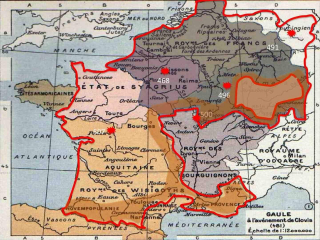 The feudal system had a fatal flaw, however. It relied on the oath of Allegiance and allegiances can be changed. By his failure to fully conquor either the Alamans or the Burgundians, plus interfaces with Vascon, Breton and Visigothic lands Clovis had created an Empire which had literally thousands of miles of border territories. These became known as marcher territories.
They were areas in which the comptes were exposed to risk of attack across the border but also able to negotiate for better terms.Even more significant was the Visigothic Empire, to the south. The Visigoths also claimed to be administrators of the Empire. In their territories the Roman system still applied. The Visigothic families took the place of the patricians, the aristocratic Roman Families but they left in place the essential elements of the Roman Administration. They too vowed an allegiance to the eastern Roman Empire. Clovis easily defeated both Syagrius and the Visigoths.
The feudal system had a fatal flaw, however. It relied on the oath of Allegiance and allegiances can be changed. By his failure to fully conquor either the Alamans or the Burgundians, plus interfaces with Vascon, Breton and Visigothic lands Clovis had created an Empire which had literally thousands of miles of border territories. These became known as marcher territories.
They were areas in which the comptes were exposed to risk of attack across the border but also able to negotiate for better terms.Even more significant was the Visigothic Empire, to the south. The Visigoths also claimed to be administrators of the Empire. In their territories the Roman system still applied. The Visigothic families took the place of the patricians, the aristocratic Roman Families but they left in place the essential elements of the Roman Administration. They too vowed an allegiance to the eastern Roman Empire. Clovis easily defeated both Syagrius and the Visigoths.
Clovis was able to the provide the lords of the lands he now controlled an unexpected bonus. In a deal brokered by the Church of Rome the local landowners were allowed to keep their lands and were allowed to claim all taxes and revenue from trading from those lands, as long as they delivered what Clovis demanded in terms of financial and military support. The feudal system was born.
Roman Administration
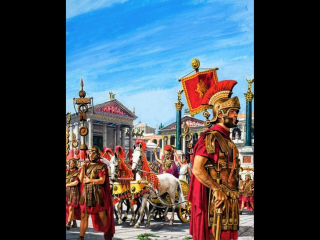 The recent (2011) discovery of 50 decapitated bodies near Maiden Castle in Dorset, England serves as a good reminder that the Pax Romana was peace for the Roman people, not necessarily for anyone else. The bodies have beed carbon dated to be victims of the Roman invasion of Britain in AD 43. From both Sygerius and the Visigoths Clovis inherited an essentially Roman administration, in some ways unchanged from the early days of the republic. The Roman system of government was complex. The whole objective was to provide wealth for Roman Citizens. There were thousands upon thousands of Roman Officials. It was not so much an administration as a means of wealth distribution. Wealth, generated by the Empire, was distributed to Roman Citizens by payment for performing public office and at the lower levels for services provided to public officials. Along with payment, all public offices offered the opportunity to take a commission on transactions under the incumbent’s control or even from a specific sphere of influence.
The recent (2011) discovery of 50 decapitated bodies near Maiden Castle in Dorset, England serves as a good reminder that the Pax Romana was peace for the Roman people, not necessarily for anyone else. The bodies have beed carbon dated to be victims of the Roman invasion of Britain in AD 43. From both Sygerius and the Visigoths Clovis inherited an essentially Roman administration, in some ways unchanged from the early days of the republic. The Roman system of government was complex. The whole objective was to provide wealth for Roman Citizens. There were thousands upon thousands of Roman Officials. It was not so much an administration as a means of wealth distribution. Wealth, generated by the Empire, was distributed to Roman Citizens by payment for performing public office and at the lower levels for services provided to public officials. Along with payment, all public offices offered the opportunity to take a commission on transactions under the incumbent’s control or even from a specific sphere of influence.
SPQR
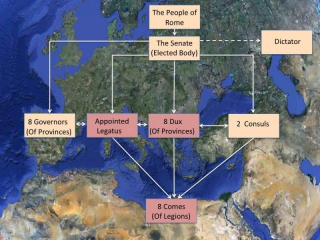 For the Senate and People of Rome. As the republic grew a “Governor” dealing with civil issues and a “Dux” dealing with military issues was appointed in every province. Also in every Province there was a “Comes”, in charge of a legion. The Comes responded to the Dux. The senate appointed two consuls who only held power for a year. It is possible to see the Consuls as “Kings for a year” and there were deliberately two of them so one could keep check on the other, However they often performed as trouble-shooters for the senate and were totally subject to the senates direction. In emergencies the Senate could appoint, for a limited time a “Dictator” who could make decisions and take action without any reference to the senate. The Senate had another control mechanism whereby it could appoint a “Legatus” who could carry out investigations in any province and most importantly take command of one or more legions.
For the Senate and People of Rome. As the republic grew a “Governor” dealing with civil issues and a “Dux” dealing with military issues was appointed in every province. Also in every Province there was a “Comes”, in charge of a legion. The Comes responded to the Dux. The senate appointed two consuls who only held power for a year. It is possible to see the Consuls as “Kings for a year” and there were deliberately two of them so one could keep check on the other, However they often performed as trouble-shooters for the senate and were totally subject to the senates direction. In emergencies the Senate could appoint, for a limited time a “Dictator” who could make decisions and take action without any reference to the senate. The Senate had another control mechanism whereby it could appoint a “Legatus” who could carry out investigations in any province and most importantly take command of one or more legions.
The Empire
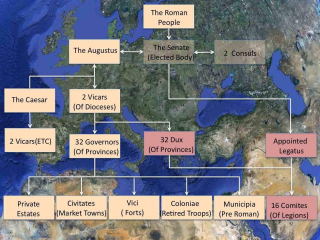 The expanding Empire was split into four “Dioceses” each one controlled by a Vicar and each Diocese was split into “Provinces”.
As the system evolved the Augustus was given a “Caesar ‘ responding to him. The Caesar had a duplicate system of Vicars, Governors etc through which he independently controlled half of the Empire. The Caesar was regarded as the “Augusta Elect” ready to take over from the Augustus when the time came.
The Empire was divided into east and west, still nominally one state, but each ruled by an Augusta and each having a Caesar in attendance.
With the passage of time the role of the senate decreased in importance. The Empire moved towards autocratic government with commands passed down the hierachy and reports transmitted upwards. The Augustus became a true dictator.
The decline in the power of the Senate was accompanied by a reduction in importance of the role of the Legate. This resulted in greater autonomy being given to the Governors, Dux and local client Kings. As concepts of Empire evolved extensive use was made of Client Kings. As long as unity of the Empire and its commercial needs were honoured, individual Kings were given a surprising level of freedom.The empire was in itself a metamorphosis from the republic. As the republic continued to grow the complex system needed a strong hand to ensure that individual public officials did not put their own interests ahead of those of the State. Initially the Augustus was simply a dictator appointed for life. Eventually the expanding Empire was split into four “Dioceses” each one controlled by a Vicar and each Diocese was assigned control of several provinces.
The expanding Empire was split into four “Dioceses” each one controlled by a Vicar and each Diocese was split into “Provinces”.
As the system evolved the Augustus was given a “Caesar ‘ responding to him. The Caesar had a duplicate system of Vicars, Governors etc through which he independently controlled half of the Empire. The Caesar was regarded as the “Augusta Elect” ready to take over from the Augustus when the time came.
The Empire was divided into east and west, still nominally one state, but each ruled by an Augusta and each having a Caesar in attendance.
With the passage of time the role of the senate decreased in importance. The Empire moved towards autocratic government with commands passed down the hierachy and reports transmitted upwards. The Augustus became a true dictator.
The decline in the power of the Senate was accompanied by a reduction in importance of the role of the Legate. This resulted in greater autonomy being given to the Governors, Dux and local client Kings. As concepts of Empire evolved extensive use was made of Client Kings. As long as unity of the Empire and its commercial needs were honoured, individual Kings were given a surprising level of freedom.The empire was in itself a metamorphosis from the republic. As the republic continued to grow the complex system needed a strong hand to ensure that individual public officials did not put their own interests ahead of those of the State. Initially the Augustus was simply a dictator appointed for life. Eventually the expanding Empire was split into four “Dioceses” each one controlled by a Vicar and each Diocese was assigned control of several provinces.
The Rule of the Augustus
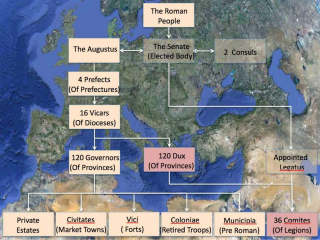 As the Empire grew larger, the administration continued to evolve. Four Pretarorian Prefects were appointed to assist with Co-ordination between Vicars. However events beyond the empire and new tactics and technology used by barbarian armies demanded even further reform.The empire expanded rapidly. The Augustus was given a “Caesar ‘ responding to him. The Caesar had a duplicate system of Vicars, Governors etc through which he independently controlled half of the Empire. The Caesar was regarded as the “Augusta Elect” ready to take over from the Augustus when the time came. The Empire was eventually divided still further into east and west, still nominally one state, but each ruled by an Augusta and each having a Caesar in attendance.
As the Empire grew larger, the administration continued to evolve. Four Pretarorian Prefects were appointed to assist with Co-ordination between Vicars. However events beyond the empire and new tactics and technology used by barbarian armies demanded even further reform.The empire expanded rapidly. The Augustus was given a “Caesar ‘ responding to him. The Caesar had a duplicate system of Vicars, Governors etc through which he independently controlled half of the Empire. The Caesar was regarded as the “Augusta Elect” ready to take over from the Augustus when the time came. The Empire was eventually divided still further into east and west, still nominally one state, but each ruled by an Augusta and each having a Caesar in attendance.
With the passage of time the role of the senate decreased in importance. The decline in the power of the Senate was accompanied by a reduction in importance of the role of the Legate. The evolution continued. Four Pretorian Prefects were appointed to assist co-ordination between Vicars.
The Magister Militum
 The strategy being used depended totally on local quick decision making. The Comitas were detached from the Dux and given the authority to command not only their troops but civil and other military personnel. Whole districts were put under their command. The organisation created occasional conflict Comitas and Magister Milatorum.
For all this to work the district civil administration had to understand the role of the Comitas and the role the civil population must play. The Comitas became increasingly independent and self reliant in the area they controlled.However events beyond the empire and increasing conflict with barbarian armies ultimately demanded even further reform. Note the fleeting appearance of the “Cardinales” who not only co-ordinated the Vicars but was responsible for their activities. However the role of military forces was enhanced, they responded directly to the Augustus and took a steadily increasing interest in civil administration. The Empire slowly became a military state. This was facilitated by the appointment of a “Magister Militorum”.
The strategy being used depended totally on local quick decision making. The Comitas were detached from the Dux and given the authority to command not only their troops but civil and other military personnel. Whole districts were put under their command. The organisation created occasional conflict Comitas and Magister Milatorum.
For all this to work the district civil administration had to understand the role of the Comitas and the role the civil population must play. The Comitas became increasingly independent and self reliant in the area they controlled.However events beyond the empire and increasing conflict with barbarian armies ultimately demanded even further reform. Note the fleeting appearance of the “Cardinales” who not only co-ordinated the Vicars but was responsible for their activities. However the role of military forces was enhanced, they responded directly to the Augustus and took a steadily increasing interest in civil administration. The Empire slowly became a military state. This was facilitated by the appointment of a “Magister Militorum”.
The strategy being used depended totally on locally based quick decision making. The Comitas were given the authority to command not only their troops but civil and other military personnel. Whole districts were put under their command. They became independent of the Dux who took over administrative duties but now responded to the Magister Militum.
The Feudal World
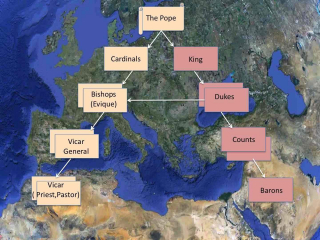 The Pope of the time developed the concept of right to rule. He maintained that Roman Emperor Constantine the Great had given the Popes of Rome the right to the temporal rule of the Western Empire. This was ultimately supported by documentation known as the “Donation of Constantine” (which much later was proved to be one of the greatest forgeries and therefore frauds, of all time). Nevertheless the Pope used this concept to intervene and appoint the untrustworthy devious, murderous, teenage leader of the Frankish tribe to be his Magister Militarum. A cursory examination of the titles chosen for the new Church of Rome hierachy shows that it was the Church itself which was intended to provide the civil governance.
The leader of the Franks was called Clovis and the Dynasty he founded the Merovingians.
There are many legends about why the Pope, chose Clovis, but it was really because he permitted the Church of Rome to adopt, at least in the short term, the role it had assigned to itself - to become the spiritual and temporal ruler of the Western Empire. Clovis became the classic Client King. His job was simply to use his ruthless political and military skills to eliminate the opposition, which he did, with brutal efficiency.The Comes began to organise themselves locally for their own defence. They became totally independent and self reliant in the area they controlled. These Comes were the Local “lords” who ultimately chose to swear allegiance to Clovis. They retained however a great measure of their independence. They became the “Comtes” of the medieval world.
The Pope of the time developed the concept of right to rule. He maintained that Roman Emperor Constantine the Great had given the Popes of Rome the right to the temporal rule of the Western Empire. This was ultimately supported by documentation known as the “Donation of Constantine” (which much later was proved to be one of the greatest forgeries and therefore frauds, of all time). Nevertheless the Pope used this concept to intervene and appoint the untrustworthy devious, murderous, teenage leader of the Frankish tribe to be his Magister Militarum. A cursory examination of the titles chosen for the new Church of Rome hierachy shows that it was the Church itself which was intended to provide the civil governance.
The leader of the Franks was called Clovis and the Dynasty he founded the Merovingians.
There are many legends about why the Pope, chose Clovis, but it was really because he permitted the Church of Rome to adopt, at least in the short term, the role it had assigned to itself - to become the spiritual and temporal ruler of the Western Empire. Clovis became the classic Client King. His job was simply to use his ruthless political and military skills to eliminate the opposition, which he did, with brutal efficiency.The Comes began to organise themselves locally for their own defence. They became totally independent and self reliant in the area they controlled. These Comes were the Local “lords” who ultimately chose to swear allegiance to Clovis. They retained however a great measure of their independence. They became the “Comtes” of the medieval world.
Clovis assumed or was persuaded that the Church of Rome would provide the civil administration. A cursory glance at the titles chosen for the church hierarchy shows that it closely mirrors the civil administration of the Empire.
